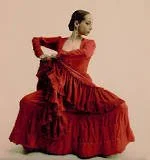Ole!
Flamenco is an ancient art form
Back in 2009 (or the “late aughts,” as the kids are calling it these days) my now-husband and I went to Spain. In Madrid, I committed a minor faux-pas by asking our concierge directions to the Casa de Patatas (the House of Potatoes). Indeed, I’d meant to say, “La Casa de Patas” (the house of feet). The show that we still somehow managed to find was extraordinary, life-changing, unlike anything either of us had ever experienced!
Which is why we were so elated to find the Royal Opera of Madrid performing right here in our hometown of Washington D.C.! Hosted at the Miracle Theater, produced by SO-LA-NA, and marketed / sold by Fever, this show was absolutely breathtaking. The amazingly talented performers, Amador Rojas (dancer), Yolanda Osuna (dancer), José Tomás Jiménez (guitar), Manu Soto (singer), Bernardo Miranda (singer), Sergio de Lope (flute and saxophone), and Lolo Plantón (percussion), each received their own standing ovation. And for good reason! From start to finish the show was captivating. I’m no expert in the art form, but I perceived through changes in the dancers’ costumes that we moved from a heated passion, to death and/or despair, and finally a wedding day (my husband also offers the suggestion that the female dancer’s white dress in the final act could also signify that she had become an angel).
Curious about the history of the dance, a few Google searches left me even more confused. One source cites a migration from Rajasthan (India) to Spain between the 9th and 14th centuries as the origination of this unique musical style. Another source cites Moorish influences, noting that Spain was a Muslim country from approximately 711 when Islamic Arabs and “Moors” of Berber descent crossed from North Africa into the Iberian Peninsula. Ferdinand and Isabella at once united the country now known as Spain, at the same time they defeated Muslim rule in 1492. Initially the new King and Queen of Spain supported religious tolerance, but they gradually succumbed to pressure from the Catholic Church to instigate the Spanish Inquisition, in which Muslims and Jews were heavily persecuted.
This would definitely explain the Islamic musical influences, but much credit also is given to “gypsies,” aka “Gitanos” who maintained a strong presence in Andalusia in the 15th century. The name “Flamenco” itself originally meant “Flemish,” as a reference to Carlos I of Spain, aka Charles V Holy Roman Emperor, aka Lord of the Netherlands, aka Duke of Burgundy. (I mean seriously, how many titles does a guy need?!) This was after the reign of Ferdinand and Isabella, of whom Charles was a direct descendent. But there are those who surmise that Flemish and Gypsy culture somehow became confounded.
Be that as it may, there is no doubt that Flemenco as a dance, musical style, and culture has become inextricably entwined with Spain. It is also enjoying a global moment, with Rosalia popularizing the style. I’m so delighted that a wider audience has the opportunity to fall under the enchantment of it’s allure, just as I have.
